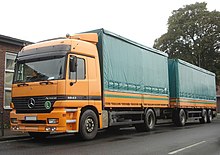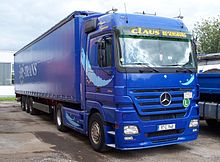
The Unimog is a line of multi-purpose tractors, trucks and lorries that has been produced by Boehringer from 1948 until 1951, and by Daimler Truck since 1951.
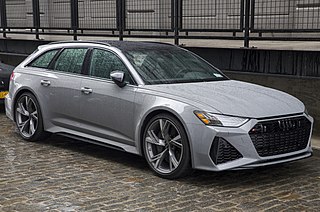
The Audi RS 6 is a high-performance variant of the Audi A6 range, produced by the high-performance subsidiary company Audi Sport GmbH, for its parent company Audi AG, a subsidiary of the Volkswagen Group, from 2002 onwards.

The Mercedes-Benz W211 is the third generation Mercedes-Benz E-Class made from 2001 to 2009 in sedan/saloon and station wagon/estate configurations – replacing the W210 E-Class models and superseded by the Mercedes-Benz W212 in 2009.
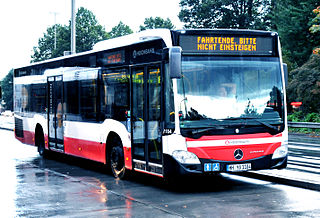
Mercedes-Benz has been producing buses since 1895 in Mannheim in Germany. Since 1995 Mercedes-Benz buses and coaches is a brand of EvoBus GmbH, a wholly owned subsidiary of Daimler Truck.

The Mercedes-Benz Atego is a range of general-purpose rigid trucks introduced by Daimler Truck in 1998. A new model was introduced in 2004, followed by a facelift in 2010 and another new model in 2013. The latest version is available in gross vehicle weights of 6.5 to 16 tonnes (t) and is powered by a straight 4- or 6-cylinder engine.

The Mitsubishi Fuso Canter is a line of light-duty commercial vehicles manufactured by Mitsubishi Fuso Truck and Bus Corporation, part of Daimler Truck, subsidiary of Mercedes-Benz Group. The Canter is manufactured since 1963, now in its eighth generation. The Canter is named after the English word describing the gait of a horse, emphasising the 'thoroughbred' nature of Mitsubishi trucks.

The Volvo FL is a series of trucks manufactured by Volvo Trucks. It was introduced in 1985 and has remained in production ever since, in a variety of different models of different weight ratings. It has been used in a variety of different roles aside from a truck, including as a fire engine.

The Volkswagen Crafter, introduced in 2006, is the largest three- to five-ton van produced and sold by the German automaker Volkswagen Commercial Vehicles. The Crafter officially replaced the Volkswagen Transporter LT that was launched in 1975, although it is known as the LT3, its production plant code.

MB-trac is a range of agricultural tractors developed and produced from 1973 until 1991 by Mercedes-Benz Group, formerly known as Daimler-Benz. It is based on the trac design principle for tractors and shares its drivetrain with the Unimog. Mercedes-Benz offered the MB-trac in light duty, medium-duty, and heavy-duty versions in four different type series: 440, 441, 442, and 443. About 41,000 MB-tracs were made by former Daimler-Benz, before the manufacture was sold to Werner Forsttechnik in the early 1990s, who developed the WF trac skidder from the MB-trac.
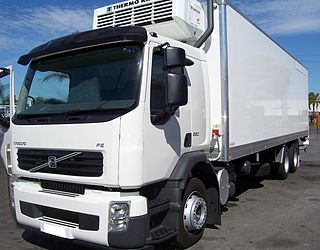
The Volvo FE is a medium duty truck produced by Volvo Trucks Corporation since 2006, now in its second generation. The FE is available in various rigid versions and a tractor version spanning three weight classes.

The trucks of the Mercedes-Benz series Schwere Klasse were produced from 1989 through 1998, when they were succeeded by the Mercedes-Benz Actros. The Mercedes Benz SK, in essence is basically a revamped Mercedes-Benz NG chassis with a few added driver comforts and electronic assistance and diagnosis. Therefore, it is a much more comfortable ride than its predecessor. There are at least two versions of Mercedes Benz SK that got licensed manufacturing by other companies.

The "New Generation“ is a series of trucks by Daimler-Benz built from 1973 to 1988. It was then replaced by the Mercedes-Benz SK series. With the "New Generation", Daimler-Benz expanded its market position in the medium and heavy truck segments. Its cab was also used by Mercedes-Benz of North America, who confusingly offered it with inline-six or -five engines as the LP series beginning in 1985.

Sisu Polar is a truck model series produced by the Finnish heavy vehicle producer Sisu Auto. It came into the market in 2011 and the main applications are earthmovers, logging trucks, road maintenance vehicles, mobile cranes and heavy machinery hauliers which are fully equipped in the factory. The series includes two main variants DK12M and DK16M. The number of axles is 3, 4 or 5. Mercedes-Benz supplies some key components; cabins and engines in particular.
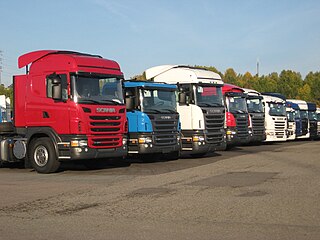
The Scania PRT-range, also referred to as new truck range or Scania's truck range, is the current range of trucks produced by the Swedish commercial vehicle manufacturer Scania. It was first introduced as the successor to the 4-series in spring 2004 with the high forward control cab Scania R-series, followed by the low forward control cab Scania P-series and bonneted cab Scania T-series later in the year. The bonneted model was discontinued in 2005. In 2007 the Scania G-series, a medium forward control cab was introduced and was derived from the R-series. The entire range is modular, giving a wide range of different configurations for different types of trucks. The trucks are available with engines ranging from a 9-litre I5 to a 16-litre V8, with the V8 only being available in the higher model. A second generation launched in August 2016, first was the Scania S-series being the first flat-floor model. In December 2017, a low-end version of the second generation, the Scania L-series, also launched.

The Unimog 401 is an all-wheel-drive vehicle of the Unimog-series by Mercedes-Benz, developed as a tractor and equipment carrier. It was produced by Daimler-Benz in the Unimog plant in Gaggenau from 1953 to 1956. A total of 16,250 Unimog 401 and 402 were made.

The Unimog 406 is a vehicle of the Unimog-series by Mercedes-Benz. A total of 37,069 units were manufactured by the Daimler-Benz AG in the Unimog plant in Gaggenau from 1963 to 1989. The 406 was the first medium duty Unimog, having a larger wheelbase of 2380 mm and more than twice the engine power of the Unimog 401. Unlike the initial Unimog, the 406 does not have a car engine but a heavy duty truck engine instead. Several following Unimog versions were based on the 406. There were eleven different types made of the Unimog 406, which were available in four models with a closed two-door or four-door cab, as Cabrio and as an OEM part. During its long production period, the 406 received several technical refinements. In 1964, the precombustion chamber diesel engine OM 312 was replaced with the direct injected OM 352. Disc brakes followed in 1973. For many enthusiasts, the Unimog 406 represents the classical Unimog, having agricultural and silvicultural applications. It was successful and the best embodiment of the word Universal-Motor-Gerät considering all prior Unimogs.

Mercedes-Benz LP "cubic" cabin trucks were a series of cab-over-engine trucks first shown in 1963. They are most commonly referred to as the "Kubische Kabine" in German, referring to the squared-off appearance of the cabin. "LP" was also used on the cab-over versions of the preceding range of Mercedes-Benz trucks. The heavy- and medium-duty models had been discontinued by 1975 as the Mercedes-Benz NG range took over, while the lighter portion of the range was only replaced in 1984, by the new LK. Mercedes-Benz LP trucks also served as basis for Tata Motors cowl trucks.

The Mercedes-Benz L 337 is a lorry made by Daimler-Benz, sold under the Mercedes-Benz brand. Introduced in March 1959, it was already discontinued in 1961, and replaced with the L 338. The L 337 is the first generation of Mercedes-Benz' heavy-duty "short-bonnet lorries", and has, in its default configuration, the "long" short bonnet, which is 300 mm longer than the typical Mercedes-Benz medium duty short-bonnet lorry's bonnet. Mercedes-Benz also offered the L 337 as a forward-control lorry, called the LP 337.
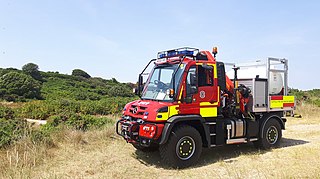
The Unimog 405 is a vehicle of the Unimog-series by Mercedes-Benz, made by Daimler Truck Holding AG. Developed in the 1990s, the Unimog 405 has been in production since 2000. Originally, DaimlerChrysler produced the Unimog at Gaggenau; in 2002, production was moved to Wörth am Rhein. The Unimog 405 is the implement carrier version of the Unimog and the successor to most previous Unimogs. Although retaining many characteristics typical of the Unimog, the 405's axle and chassis design concept with control arms instead of torque tubes marks a "paradigmatic change" in Unimog design.

